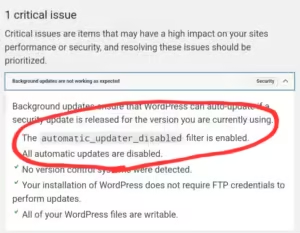
How to Fix Automatic Updater Disabled Error in WordPress
As a WordPress site owner, you know how crucial it is to keep your site updated. This ensures your site runs smoothly, stays secure, and works as expected. But sometimes, you might run into the “automatic_updater_disabled” error. This error stops your WordPress site from getting important security updates. It’s a big risk to your site’s safety, making it open to cyber threats.
In this article, we’ll look into why this error happens and give you a step-by-step guide. We’ll show you how to fix this issue and make sure your WordPress site can update automatically again.
Key Takeaways
- Understand the causes of the “automatic_updater_disabled” error in WordPress
- Identify the problematic Must-Use plugin causing the issue
- Learn how to disable the “Automatic_Updater_Disabled” error by renaming the plugin
- Explore the benefits of removing the outdated Must-Use plugin
- Implement best practices to prevent future automatic updater disabled errors

Understanding the Automatic Updater Disabled Error
The “causes automatic_updater_disabled error” in WordPress often happens when a Must-Use plugin is in the wp-content/mu-plugins/ directory. This plugin stops the automatic update feature. This can make your WordPress site open to security risks and outdated software.
What Causes the Error?
A Must-Use plugin is usually the reason for the impact of automatic updater disabled. These plugins start automatically when WordPress starts. They are key for your WordPress site to work right, but sometimes they block the automatic update process.
With a Must-Use plugin around, it can change the default WordPress update settings. This stops the WordPress security risks from being updated automatically. Your site could then face security threats and miss out on updates and fixes.
Impact on WordPress Site
The “automatic_updater_disabled error” can affect your WordPress site in several ways:
- Your WordPress core, plugins, and themes won’t update automatically, making your site open to security issues.
- You might not get important updates and bug fixes, which can hurt your site’s performance and functionality.
- Manual updates are needed, which can be time-consuming and might cause compatibility problems or breakages.
Fixing the “causes automatic_updater_disabled error” is key to keep your WordPress site secure, up-to-date, and running well.
Identifying the Must-Use Plugin Issue
To fix the “automatic_updater_disabled” error, start by finding the Must-Use plugin that’s causing trouble. This plugin is usually the only .php file in the wp-content/mu-plugins/ directory on your WordPress site.
The WordPress mu-plugins directory is a special place for plugins that load automatically on every page. It’s great for some tasks but can cause issues if a must-use plugin clashes with WordPress’ automatic updates.
- First, go to your WordPress site’s backend and find the wp-content/mu-plugins/ directory.
- Look through the files in this directory for any .php files that might be the problematic plugin causing the “automatic_updater_disabled” error.
- If you spot a suspicious plugin, try disabling it by renaming or moving the file to another directory, as we’ll cover next.
Finding the must-use plugin causing error is key to solving the “automatic_updater_disabled” problem on your WordPress site. By pinpointing and fixing the problematic plugin, you can ensure your site updates properly.
Disable “Automatic_Updater_Disabled Error” by Renaming the Plugin
Renaming a Must-Use plugin can fix the “automatic_updater_disabled” error in WordPress. This easy step helps you manage your site’s updates again. It ensures your WordPress runs smoothly.
Step-by-Step Guide
Here’s how to disable the “automatic_updater_disabled” error by renaming the Must-Use plugin:
- Find the must-use plugin causing trouble. It’s usually in the
wp-content/mu-pluginsfolder.

🔸 Then long press the hotstinger-mu- plugin.php to rename it (1)
🔸Change the plugin’s name by adding a .disabled extension. For example, rename problem-plugin.php to problem-plugin.php.disabled.
🔸Or, put the plugin in a new disabled folder inside mu-plugins.
Save your changes and check your WordPress site. The “automatic_updater_disabled” error should be gone, and updates should work again.
Renaming or moving the must-use plugin disables it. This fixes the “automatic_updater_disabled” problem. Your WordPress site can now update without any issues.
Moving the Problematic Plugin to a Different Directory
If you’re seeing the “automatic_updater_disabled” error in WordPress, try moving the Must-Use plugin to a different spot. This can help fix the issue and let updates work again.
The WordPress mu-plugins directory holds essential plugins that load on every page. These plugins might be causing the “automatic_updater_disabled” error.
Move the plugin to a new spot to see if it fixes the problem. Here’s how:
- Find the plugin causing the error by checking the WordPress mu-plugins directory. Look for plugins you don’t recognize or made yourself.
- Change the plugin’s name to something like “problematic-plugin-backup” for a safety copy.
- Put the renamed plugin in a different WordPress directory, like “plugins” or “custom-plugins”.
- Clear your WordPress cache and check the site to see if the error is gone.
If the error doesn’t go away, you might need to try other fixes. This could mean removing the old Must-Use plugin or checking for other plugins causing trouble.
By doing these steps, you can find and fix the “automatic_updater_disabled” error. This ensures your WordPress site gets updates and security patches smoothly.
Removing the Outdated Must-Use Plugin
If renaming or moving the problematic must-use plugin doesn’t fix the “Automatic_Updater_Disabled” error, you might need to remove it. This will let your WordPress site start updating automatically again. It keeps your software safe and current.
Benefits of Removing the Plugin
Removing the outdated must-use plugin has many benefits for your WordPress site:
- It brings back the ability to get WordPress security updates. This is key for keeping your website safe and sound.
- It fixes the issue that caused the remove must-use plugin error, so your site runs smoothly.
- It makes managing plugins easier by getting rid of a plugin you don’t need.
By doing this, you take back control of your WordPress site’s updates. You’ll feel more secure knowing your platform is fully updated and safe.
Checking for Additional Must-Use Plugins
After fixing the first Must-Use plugin causing the “automatic_updater_disabled” error, check your WordPress site for more. It’s key to find and fix all Must-Use plugins to make automatic updates work right.
Must-Use plugins live in WordPress’s mu-plugins directory. It’s vital to look through this area. These plugins start automatically when your site boots up. They can greatly affect how your site works, including updates.
To find more Must-Use plugins causing the “automatic_updater_disabled” error, follow these steps:
- Go to your WordPress site’s dashboard and find the Plugins section.
- Search for plugins labeled as “Must-Use” or “MU”.
- Read the descriptions and what these plugins do to spot any that might disable updates.
- If you find more Must-Use plugins causing trouble, fix them as before, like renaming or moving them.
Managing WordPress mu-plugins well is key for a stable and safe WordPress site. By troubleshooting automatic_updater_disabled and checking for other plugins, your site’s updates will work right. This also lowers the chance of security issues or other problems.
Preventing Future Automatic Updater Disabled Errors
To stop the “automatic_updater_disabled” error on your WordPress site, follow best practices for managing plugins. Regularly check your plugins, choose wisely, and update your WordPress often. This keeps your site secure and running smoothly.
Best Practices for Plugin Management
Here are some tips to keep your WordPress site safe and avoid the “automatic_updater_disabled” error:
- Regularly review your installed plugins: Check each plugin’s purpose, how it works, and if it fits with your WordPress version. Remove any plugins that are old or not used.
- Carefully vet new plugins before installation: Look into the plugin’s reputation, reviews, and if it works with your WordPress version. Make sure the plugin is updated often by its creator.
- Keep your WordPress installation up-to-date: Update your WordPress, themes, and plugins regularly. This stops security issues and compatibility problems.
- Avoid installing must-use plugins: Don’t use must-use plugins unless you really need them. They can mess with the WordPress update process and cause the “automatic_updater_disabled” error.
- Backup your WordPress site regularly: Keep backups of your website, database, and files. This lets you quickly fix your site if there are problems, like the “automatic_updater_disabled” error.
By using these WordPress plugin management tips, you can prevent automatic_updater_disabled errors and keep your WordPress site secure.
Conclusion
Now, you should know how to fix the “automatic_updater_disabled” error in your WordPress site. It’s important to keep an eye on your plugins and update your WordPress regularly. This keeps your site safe and working well.
The main step to fix the error is finding and fixing the problem plugin. If a plugin is causing trouble, disable or remove it. This will bring back automatic updates and keep your site safe with the latest security and features.
Keeping your WordPress site secure and up-to-date is key to protecting your online presence and your users’ data. By using the tips from this article, you can avoid the “automatic_updater_disabled” error. This way, your WordPress site will stay secure and run smoothly.
FAQ
What causes the “automatic_updater_disabled” error in WordPress?
The “automatic_updater_disabled” error happens when a Must-Use plugin is in the wp-content/mu-plugins/ directory. This plugin stops automatic updates, making your WordPress site vulnerable to security risks and outdated software.
How does the “automatic_updater_disabled” error impact my WordPress site?
The “automatic_updater_disabled” error can seriously affect your WordPress site’s security and functionality. Without automatic updates, your site may face security risks and bugs. This can lead to hacks, data breaches, and other malicious activities.
How can I identify the Must-Use plugin causing the “automatic_updater_disabled” error?
To find the Must-Use plugin causing the error, check the wp-content/mu-plugins/ directory on your WordPress site. The problematic plugin is usually the only .php file there.
How can I disable the “automatic_updater_disabled” error by renaming the plugin?
Renaming the problematic Must-Use plugin can fix the “automatic_updater_disabled” error. You can add a .disabled extension to the file or move it to a “disabled” directory in the mu-plugins folder.
Can I move the problematic Must-Use plugin to a different directory to resolve the error?
Yes, moving the problematic Must-Use plugin to another directory can solve the “automatic_updater_disabled” error. This helps isolate the issue and lets your automatic updates work again.
What are the benefits of removing the outdated Must-Use plugin?
If renaming or moving the plugin doesn’t work, removing it might be necessary. This lets your WordPress site update automatically again, keeping your software secure and current.
How can I check for additional Must-Use plugins that may be causing issues?
After fixing the first Must-Use plugin, look for others that might be causing problems. Finding and fixing all problematic plugins ensures your automatic updates work right.
How can I prevent future “automatic_updater_disabled” errors in WordPress?
To avoid “automatic_updater_disabled” errors later, follow best practices for managing plugins. Regularly check and update your plugins, carefully choose new ones, and keep your WordPress up-to-date.











